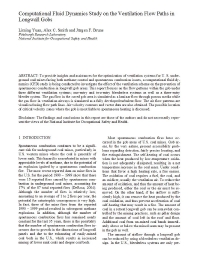 |
To provide insights into and assistance for the optimization of ventilation systems for U.S. underground coal mines facing both methane control and spontaneous combustion issues, a computational fluid dynamics (CFD) study is being conducted to investigate the effect of the ventilation scheme on preventing spontaneous combustion in longwall gob areas. This report focuses on the flow patterns within the gob under three different ventilation systems; one-entry and two-entry bleederless systems as well as a three-entry bleeder system. The gas flow in the caved gob area is simulated as a laminar flow through porous media, while the gas flow in ventilation airways is simulated as a fully developed turbulent flow. The airflow patterns are visualized using flow path lines. Air velocity contours and vector data are also obtained. The possible location of critical velocity zones where the gob is most liable to spontaneous heating is discussed.
| Author(s): | Yuan-L, Smith-AC, Brune-JF |
| Reference: | Proceedings of the 11th U.S./North American Mine Ventilation Symposium, University Park, Pennsylvania, June 5-7, 2006. Mutmansky JM, Ramani RV. eds., London, U.K.: Taylor & Francis Group, 2006 Jun; :591-598 |
cfdso (PDF, 599 KB)